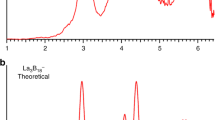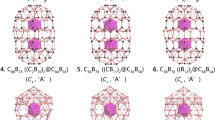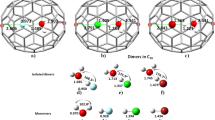Abstract
Fullerenes tend to follow the isolated pentagon rule, which requires that each of the 12 pentagons is surrounded only by hexagons. Over the past decade many violations to this rule were reported for endohedral fullerenes. Based on the ionic model M3N6+@C2n6− and the orbital energies of the isolated cages, in 2005 we formulated a molecular orbital rule to identify the most suitable hosting cages in endohedral metallofullerenes. Now, we give physical support to the orbital rule, and we propose the maximum pentagon separation rule, which can be applied to either isolated pentagon rule cages or to non-isolated pentagon rule cages with the same number of adjacent pentagon pairs. The maximum pentagon separation rule can be formulated as 'The electron transfer from the internal cluster to the fullerene host preferentially adds electrons to the pentagons; therefore, the most suitable carbon cages are those with the largest separations among the 12 pentagons'.
This is a preview of subscription content, access via your institution
Access options
Subscribe to this journal
Receive 12 print issues and online access
$259.00 per year
only $21.58 per issue
Buy this article
- Purchase on Springer Link
- Instant access to full article PDF
Prices may be subject to local taxes which are calculated during checkout





Similar content being viewed by others
References
Krätschmer, W., Lamb, L. D., Fostiropoulos, K. & Huffman, D. R. Solid C60: a new form of carbon. Nature 347, 354–357 (1990).
Beer, F., Gugel, A., Martin, K., Rader, J. & Mullen, K. High-yield reactive extraction of giant fullerenes from soot. J. Mater. Chem. 7, 1327–1330 (1997).
Kroto, H. W. The stability of the fullerenes Cn, with n = 24, 28, 32, 36, 50, 60 and 70. Nature 329, 529–531 (1987).
Kroto, H. W., Heath, J. R., O'Brien, S. C., Curl, R. E. & Smalley, R. E. C60: buckminsterfullerene. Nature 318, 162–164 (1985).
Heath, J. R. et al. Lanthanum complexes of spheroidal carbon shells. J. Am. Chem. Soc. 107, 7779–7780 (1985).
Akasaka, T. & Nagase, S. Endofullerenes: A New Family of Carbon Clusters (Springer, 2002).
Stevenson, S. et al. Small-bandgap endohedral metallofullerenes in high yield and purity. Nature 401, 55–57 (1999).
Stevenson, S. et al. Materials science: a stable non-classical metallofullerene family. Nature 408, 427–428 (2000).
Chaur, M. N., Valencia, R., Rodriguez-Fortea, A., Poblet, J. M. & Echegoyen, L. Trimetallic nitride endohedral fullerenes: experimental and theoretical evidence for the M3N6+@C6−2n model. Angew. Chem. Int. Ed. 48, 1425–1428 (2009).
Wang, C. R. et al. A scandium carbide endohedral metallofullerene: (Sc2C2)@C84 . Angew. Chem. Int. Ed. 40, 397–399 (2001).
Iiduka, Y et al. Experimental and theoretical studies of the scandium carbide endohedral metallofullerene Sc2C2@C82 and its carbene derivative. Angew. Chem. Int. Ed. 46, 5562–5564 (2007).
Iiduka, Y. et al. Structural determination of metallofullerene Sc3C82 revisited: a surprising finding. J. Am. Chem. Soc. 127, 12500–12501 (2005).
Wang, S.-T. et al. Russian-doll-type metal carbide endofullerene: synthesis, isolation, and characterization of Sc4C2@C80 . J. Am. Chem. Soc. 131, 16646–16647 (2009).
Stevenson, S. et al. A distorted tetrahedral metal oxide cluster inside an icosahedral carbon cage. Synthesis, isolation, and structural characterization of Sc4(μ3-O)2@Ih-C80 . J. Am. Chem. Soc. 130, 11844–11845 (2008).
Mercado, B. Q. et al. A seven atom cluster in a carbon cage, the crystallographically determined structure of Sc4(μ3-O)3@Ih-C80 . Chem. Commun. 279–281 (2010).
Dunsch, L. et al. Metal sulfide in a C82 fullerene cage: a new form of endohedral clusterfullerenes. J. Am. Chem. Soc. 132, 5413–5421 (2010).
Lu, X. et al. Chemical understanding of a non-IPR metallofullerene: stabilization of encaged metals on fused-pentagon bonds in La2@C72 . J. Am. Chem. Soc. 130, 9129–9136 (2008).
Yang, S. & Dunsch, L. Di- and tridysprosium endohedral metallofullerenes with cages from C94 to C100 . Angew. Chem. Int. Ed. 45, 1299–1302 (2006).
Melin, F. et al. The large Nd3N@C2n (40 ≤ n ≤ 49) cluster fullerene family: preferential templating of a C88 cage by a trimetallic nitride cluster. Angew. Chem. Int. Ed. 46, 9032–9035 (2007).
Mercado, B. Q. et al. Isolation and structural characterization of the molecular nanocapsule Sm2@D3d(822)-C104 . Angew. Chem. Int. Ed. 48, 9114–9116 (2009).
Yang, H. et al. Detection of a family of gadolinium-containing endohedral fullerenes and the isolation and crystallographic characterization of one member as a metal-carbide encapsulated inside a large fullerene cage. J. Am. Chem. Soc. 130, 17296–17300 (2008).
Che, Y. et al. Isolation and structural characterization of two very large, and largely empty, endohedral fullerenes: Tm@C3v-C94 and Ca@C3v-C94 . Inorg. Chem. 48, 6004–6010 (2009).
Beavers, C. M. et al. An improbable, egg-shaped endohedral fullerene that violates the isolated pentagon rule. J. Am. Chem. Soc. 128, 11352–11353 (2006).
Wang, C. R. et al. Materials science: C66 fullerene encaging a scandium dimer. Nature 408, 426–427 (2000).
Tan, Y.-Z., Xie, S.-Y., Huang, R.-B. & Zheng, L.-S. The stabilization of fused-pentagon fullerene molecules. Nature Chem. 1, 450–460 (2009).
Chaur, M. N., Melin, F., Ortiz, A. L. & Echegoyen, L. Chemical, electrochemical, and structural properties of endohedral metallofullerenes. Angew. Chem. Int. Ed. 48, 7514–7538 (2009).
Campanera, J. M., Bo, C. & Poblet, J. M. General rule for the stabilization of fullerene cages encapsulating trimetallic nitride templates. Angew. Chem. Int. Ed. 44, 7230–7233 (2005).
Valencia, R., Rodriguez-Fortea, A. & Poblet, J. M. Understanding the stabilization of metal carbide endohedral fullerenes M2C2@C82 and related systems. J. Phys. Chem. A 112, 4550–4555 (2008).
Popov, A. A. & Dunsch, L. Structure, stability, and cluster-cage interactions in nitride clusterfullerenes M3N@C2n (M = Sc, Y; 2n = 68–98): a density functional theory study. J. Am. Chem. Soc. 129, 11835–11849 (2007).
Raghavachari, K. Ground state of C84: two almost isoenergetic isomers. Chem. Phys. Lett. 190, 397–400 (1992).
Zettergren, H., Alcamí, M. & Martín, F. Fullerenes containing a uniform distribution of pyrenes and adjacent pentagons. Chem. Phys. Chem. 8, 861–866 (2008).
Morokuma, K. Molecular orbital studies of hydrogen bonds. III. C=O · · · H–O hydrogen bond in H2CO · · · H2O and H2CO · · · 2H2O. J. Chem. Phys. 55, 1236–1244 (1971).
Poblet, J. M., Lopez, X. & Bo, C. Ab initio and DFT modelling of complex materials: towards the understanding of electronic and magnetic properties of polyoxometalates. Chem. Soc. Rev. 32, 297–308 (2003).
Fowler, P. W. & Manolopoulos, D. E. An Atlas of Fullerenes (Oxford Univ. Press, 1995).
Mercado, B. Q. et al. Is the isolated pentagon rule merely a suggestion for endohedral fullerenes? The structure of a second egg-shaped endohedral fullerene Gd3N@Cs(39663)-C82 . J. Am. Chem. Soc. 130, 7854–7855 (2008).
Yang, S. F., Popov, A. A. & Dunsch, L. Violating the isolated pentagon rule (IPR): the endohedral non-IPR C70 cage of Sc3N@C70 . Angew. Chem. Int. Ed. 46, 1256–1259 (2007).
Kato, H., Taninaka, A., Sugai, T. & Shinohara, H. Structure of a missing-caged metallofullerene: La2@C72 . J. Am. Chem. Soc. 125, 7782–7783 (2003).
Shi, Z.-Q., Wu, X., Wang, C.-R., Lu, X. & Shinohara, H. Isolation and characterization of Sc2C2@C68: a metal-carbide endofullerene with a non-IPR carbon cage. Angew. Chem. Int. Ed. 45, 2107–2111 (2006).
Müller, A., Krickemeyer, E., Bogge, H., Schmidtmann, M. & Peters, F. An inorganic super fullerene and Keplerate based on molybdenum oxide. Angew. Chem. Int. Ed. 37, 3359–3363 (1998).
Sigmon, G. E. et al. Symmetry versus minimal pentagonal adjacencies in uranium-based polyoxometalate fullerene topologies. Angew. Chem. Int. Ed. 48, 2737–2740 (2009).
Becke, A. D. Density-functional exchange-energy approximation with correct asymptotic behavior. Phys. Rev. A 38, 3098–3100 (1988).
Perdew, J. P. Density-functional approximation for the correlation energy of the inhomogeneous electron gas. Phys. Rev. B 33, 8822–8824 (1986).
Olmstead, M. M. et al. Isolation and structural characterization of the endohedral fullerene Sc3N@C78 . Angew. Chem. Int. Ed. 40, 1223–1225 (2001).
Yamada, M., Akasaka, T. & Nagase, S. Endohedral metal atoms in pristine and functionalized fullerene cages. Acc. Chem. Res. 43, 92–102 (2010).
Cai, T. et al. Structure and enhanced reactivity rates of the D5hSc3N@C80 and Lu3N@C80 metallofullerene isomers: the importance of the pyracylene motif. J. Am. Chem. Soc. 128, 8581–8589 (2006).
Olmstead, M. M., de Bettencourt-Dias, A., Stevenson, S., Dorn, H. C. & Balch, A. L. Crystallographic characterization of the structure of the endohedral fullerene {Er2@C82 isomer I} with Cs cage symmetry and multiple sites for erbium along a band of ten contiguous hexagons. J. Am. Chem. Soc. 124, 4172–4173 (2002).
Zuo, T. et al. Isolation and structural characterization of a family of endohedral fullerenes including the large, chiral cage fullerenes Tb3N@C88 and Tb3N@C86 as well as the Ih and D5h isomers of Tb3N@C80 . J. Am. Chem. Soc. 129, 2035–2043 (2007).
Valencia, R., Rodriguez-Fortea, A. & Poblet, J. M. Large fullerenes stabilized by encapsulation of metallic clusters. Chem. Commun. 4161–4163 (2007).
Acknowledgements
This work was supported by the Spanish Ministerio de Ciencia e Innovación (CTQ2008-06549-C02-01/BQU and the Ramon y Cajal Program) and by the Generalitat de Catalunya (2009SGR-00462 and XRQTC). We thank S. Alvarez for discussions on icosahedral species.
Author information
Authors and Affiliations
Contributions
A.R.-F. planned the calculations, developed specific codes to select the structures, charges and data in general, and carried out AM1 and DFT calculations; N.A. carried out DFT calculations; A.L.B. devised the project, discussed the results and co-wrote the paper; J.M.P. coordinated the project, discussed the results and co-wrote the paper.
Corresponding author
Ethics declarations
Competing interests
The authors declare no competing financial interests.
Supplementary information
Supplementary information
Supplementary information (PDF 665 kb)
Rights and permissions
About this article
Cite this article
Rodríguez-Fortea, A., Alegret, N., Balch, A. et al. The maximum pentagon separation rule provides a guideline for the structures of endohedral metallofullerenes. Nature Chem 2, 955–961 (2010). https://doi.org/10.1038/nchem.837
Received:
Accepted:
Published:
Issue Date:
DOI: https://doi.org/10.1038/nchem.837
This article is cited by
-
Characterization of a strong covalent Th3+–Th3+ bond inside an Ih(7)-C80 fullerene cage
Nature Communications (2021)
-
Fullerenes C100 and C108: new substructures of higher fullerenes
Structural Chemistry (2021)
-
Modification of boron nitride nanocages by titanium doping results unexpectedly in exohedral complexes
Nature Communications (2019)
-
Transformation of doped graphite into cluster-encapsulated fullerene cages
Nature Communications (2017)
-
Cage connectivity and frontier π orbitals govern the relative stability of charged fullerene isomers
Nature Chemistry (2015)



